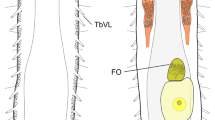Abstract
Zoantharia (or Zoanthidea) is the third largest order of Hexacorallia, characterised by two rows of tentacles, one siphonoglyph and a colonial way of life. Current systematics of Zoantharia is based exclusively on morphology and follows the traditional division of the group into the two suborders Brachycnemina and Macrocnemina, each comprising several poorly defined genera and species. To resolve the phylogenetic relationships among Zoantharia, we have analysed the sequences of mitochondrial 16S and 12S rRNA genes obtained from 24 specimens, representing two suborders and eight genera. In view of our data, Brachycnemina appears as a monophyletic group diverging within the paraphyletic Macrocnemina. The macrocnemic genus Epizoanthus branches as the sister group to all other Zoantharia that are sampled. All examined genera are monophyletic, except Parazoanthus, which comprises several independently branching clades and individual sequences. Among Parazoanthus, some groups of species can be defined by particular insertion/deletion patterns in the DNA sequences. All these clades show specificity to a particular type of substrate such as sponges or hydrozoans. Substrate specificity is also observed in zoantharians living on gorgonians or anthipatharians, as in the genus Savalia (Gerardia). If confirmed by further studies, the substrate specificity could be used as reliable character for taxonomic identification of some Macrocnemina.




Similar content being viewed by others
References
Beagley CT, Okimoto R, Wolstenholme DR (1998) The Mitochondrial genome of the sea anemone Metridium senile (Cnidaria): introns, a paucity of tRNA genes, and a near-standard genetic code. Genetics 148:1091–1108
Burnett WJ, Benzie JAH, Beardmore JA, Ryland JS (1997) Zoanthids (Anthozoa, Hexacorallia) from the Great Barrier Reef and Torres Straits, Australia: Systematics, evolution and a key to species. Coral Reefs 16:55–68
Crocker LA, Reiswig HM (1981) Host specificity in sponge-encrusting Zoanthidea (Anthozoa: Zoantharia) of Barbados, West Indies. Mar Biol 65:231–236
Delage Y, Hérouard E (1901) Traité de Zoologie concrète Volume 2 les Coelentérés. Schleicher Frères, Paris
Gravier C (1918) Note sur une Actinie (* Thoracactis* n. g., * topsenti* n. sp.) et un Annélide Polychète (* Hermadion Fauveli* n. sp.), commensaux d’une Éponge siliceuse (* Sarostegia oculata* Topsent). Bull Inst Oceanogr 344:1–20
Haddon AC, Shackleton AM (1891) Reports on the zoological collections made in Torres Straits by Professor A.C. Haddon, 1888–1889. Actiniae: I. Zoantheae. Sci Trans R Dublin Soc 4:673–701
Häussermann V (2003) Zoanthidea. In: Das Mittelmeer, bestimmungsführer Band II/1 (Hofrichter R.).—Heidelberg: Spektrum, Akad. Verl. pp 501–505
Hall TA (1999) BioEdit: a user-friendly biological sequence alignement editor and analysis program for Windows 95/98/NT. Nucleic Acids Symp Ser 41:95–98
Herberts C (1972) Etude systématique de quelques zoanthaires tempérés et tropicaux. Téhtys suppl 3:69–156
Huelsenbeck JP, Ronquist F (2001) MrBayes: a program for the Bayesian inference of phylogeny. Available from http://morphbank.ebc.uu.se/mrBayes3/manual.php
Kishino H, Hasegawa M (1989) Evaluation of the maximum likelihood estimate of the evolutionary tree topologies from DNA sequence data, and the branching order in Hominoidea. J Mol Evol 29:170–179
Lacaze-Duthiers H (1864) Mémoires sur les antipathaires (Genre Gerardia, L. D.). Ann Sci Nat 2(5):169–239
Le Goff-Vitry MC, Rogers AD, Baglow D (2004) A deep sea slant on the molecular phylogeny of the Scleractinia. Mol Phyl Evol 30:167–177
Ocaña O, Brito A (2003) A review of Gerardiidae (Anthozoa: Zoantharia) from the Macaronesian islands and the Mediterranean sea with the description of a new species. Rev Acad Canar Cienc XV 3–4:159–189
Posada D, Crandall KA (1998) MODELTEST: testing the model of DNA substitution. Bioinformatics 14:419–431
Ryland JS, Muirhead AM (1993) Order Zoanthidea (Class Anthozoa, Zoantharia). In: Mather P, Bennett I (eds) A coral reef handbook, 3rd edn. Surrey Beatty& Son Pty Ltd, Sydney, pp 52–58
Ryland JS (1997) Reproduction in Zoanthidea (Anthozoa: Hexacorallia). Invert Reprod Dev 31:177–188
Ryland JS, de Putron S, Scheltema RS, Chimonides PJ, Zhadan DG (2000) Semper’s (zoanthid) larvae: pelagic life, parentage and other problems. Hydrobiologia 440:191–198
Ryland JS, Lancaster JE (2003) Revision of methods for separating species of Protopalythoa (Hexacorallia: Zoanthidea) in the tropical West Pacific. Invert Syst 17:407–428
Ryland JS, Brasseur MM, Lancaster JE (2004) Use of cnidae in taxonomy: implications from a study of Acrozoanthus australiae (Hexacorallia, Zoanthidea). J Nat Hist 38:1193–1223
Sanchez AJ, Lasker HR, Taylor DJ (2003) Phylogenetic analyses among octocorals (Cnidaria): mitochondrial and nuclear DNA sequences (lsu-rRNA, 16S and ssu-rRNA, 18S) support two convergent clades of branching gorgonians. Mol Phyl Evol 29: 31–42
Schmidt H (1974) On the evolution in the Anthozoa. In: Cameron AM, Campbell BM, Cribb AB, Endean R, Jell JS, Jones OA, Mather P, Talbot FH (eds) The Great Barrier Reef Committee, Brisbane. Proceedings of the 2nd international symposium on coral reefs, vol 1, pp 533–560
Schmidt H (1979) Die Spermien der Anthozoen und ihre phylogenetische Bedeutung. Zoologica 44(129):1–46
Swofford DL (2002) PAUP*: phylogenetic analysis using parsimony (*and other methods), version 4.0b10. Sinauer, Sunderland
Tischbierek H (1930) Zoanthiden auf Wurmröhren. Zool Anz 91:91–95
Veron JEN (1995) Corals in space and time; the biogeography and the evolution of Scleractinia. UNSW Press, Sydney, p 321
Acknowledgments
We are grateful to L. Zaninetti for her enthusiasm and constant support for this study and to H. Zibrowius for his precious naturalist advices and ideas. We thank the divers who collected the samples: M. Boyer and P. Wirtz; J. Wuest and M. Crevecoeur’s group (Geneva), C. Bezac and C. Marschal (Marseille) for their help with the histology, J.D. Reimer for his advice on the manuscript, as well as to P. Schuchert and J. Vacelet for help in identification of hydrozoans and sponges. All the experiments comply with the current laws of the country in which they were conducted.
Author information
Authors and Affiliations
Corresponding author
Additional information
Communicated by O. Kinne, Oldendorf/Luhe
Rights and permissions
About this article
Cite this article
Sinniger, F., Montoya-Burgos, J.I., Chevaldonné, P. et al. Phylogeny of the order Zoantharia (Anthozoa, Hexacorallia) based on the mitochondrial ribosomal genes. Marine Biology 147, 1121–1128 (2005). https://doi.org/10.1007/s00227-005-0016-3
Received:
Accepted:
Published:
Issue Date:
DOI: https://doi.org/10.1007/s00227-005-0016-3




